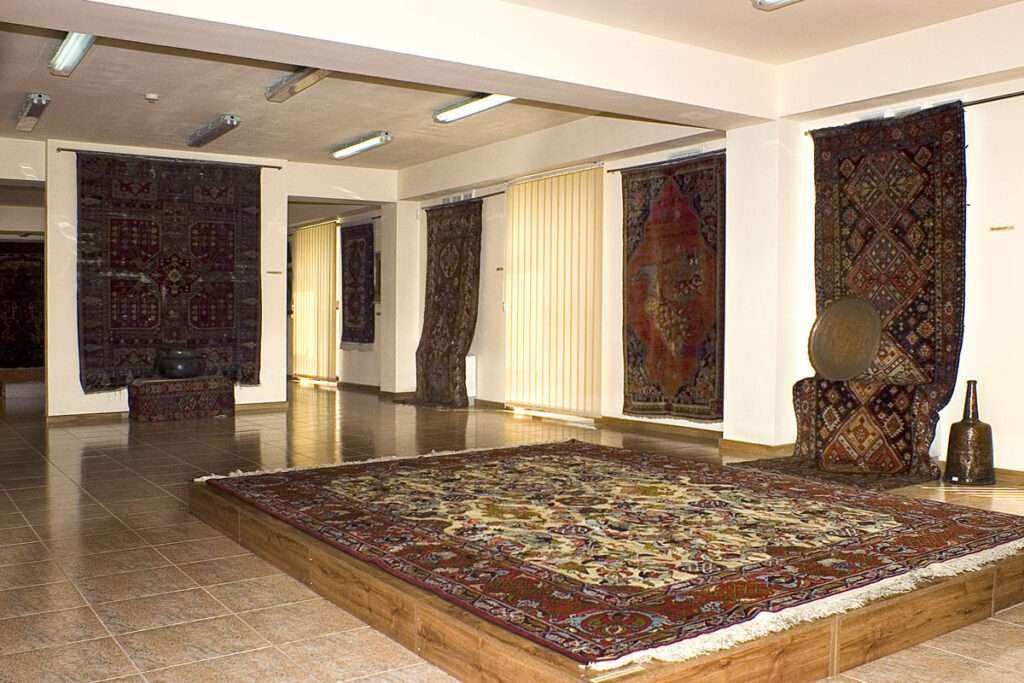Ethnographic

The rich ethnographic collection of the museum represents the everyday life, occupations, crafts, clothes, furnishings of the residents of Yerevan. The collection includes valuable carpets, arts, woven items such as saddlebags, salt purses, bedclothes and so on. They refer to the 17-20 centuries the oldest of which is “Partizagorts” woven at the end of the 17th century in Vaspurakan. The collection includes both Armenian (Artsakh, Lori Pambak, Syunik, Western Armenia) carpets and the ones from Persia, Middle Asia and other carpet weaving centers.
According to the ornaments the collection is classified into Vishapagorts (dragon-ornamented), Astgh-havq (stars and birds ornamented), Jraberd (water fortress ornamented), Memling carpets and Patkeragorts (picture-ornamented). Besides the carpets of classical style there are jubilee carpets and the ones with the portraits of public figures of the Soviet time. The collection has been replenished with the carpets manufactured by “Haygorg” company by the sketches made by carpet painters Makar Mnatsakanyan, Hakob Keshishyan and others, as well as with the carpets presented from different countries.
The collection of national costumes is diverse from the point of view their geography and period of time: there are national costumes typical for only Yerevan, which is particularly notable with a wedding outfit. The national outfit of Bardzr Hayq, Alexandropol, Hamshen, Trabzon, Lori and other districts expresses the diversity of Yerevan population.
The samples of Persian costumes comprise a big group testifying the multi-ethnic population of Yerevan. The European outfit occupies an important place too. This part of the collection is valuable as it contains information on the outstanding Yerevanians-scientists, engineers, cultural figures and representatives of noble families. The garments belonging to architect Alexander Tamanyan, pianist Olga Vagenheim, the teacher of Hripsimyan female gymnasium Korshunova and other are kept here. And the suit belonging to the noble family of Melik- Aghamalyans was made by Melik Sahak’s order. Dressed in this costume he appeared before tsar Nikolay I in Tiflis in 1834. This costume was handed down from generation to generation as a family value. The last heir of the dynasty Sasha Melik -Aghamalyan handed it to the museum.
The collection mainly includes the samples of festive clothes which were kept in chests and used only on festivals and were often handed down from generation to generation. Everyday clothes were worn till they became worn out and useless therefore they couldn’t appear in the museum.
The collection of textiles includes a number of flags which are of historical significance. Here are the Persian and English flags taken during the capture of Yerevan fortress on October 1, 1827 during the Russian-Persian war of 1826-1828. Each guild had its flag; the flag of the guild of tanners and other ones are kept in the museum.
There are numerous copper household items included in the ethnographic collection. These items are made with great skill, with carved ornaments, there are also plain copper items in the collection. Beautifully decorated copper samples of Persian origin have their place in the collection too.
Household earthenware utensils have kept the national traditional elements of crockery; they include milk, wine, salt and other pots. The salt-cellars which symbolize the worship of goddess Anahit are made in the form of a pregnant woman to honour the goddess of fertility Anahit.
The city life can’t be imagined without furniture. The collection includes the samples of the furniture used by the residents of Yerevan in the 19-20 centuries and these samples can be classified as follows: European furniture brought from abroad, furniture made by Armenian masters in a mixed style, i.e. the furniture is European but it is ornamented in Armenian technique. This kind of furniture was common at the end of the 19th century and at the beginning of the 20th century as it didn’t yield to European furniture and met the requirements of the wealthy layer of the society. Among them one can find cupboards, wardrobes, chests of drawers, writing tables made of walnut or beech wood. The collection also includes samples made by a special private order for eminent figures. In particular, the bedroom furniture of eminent statesman Aghasi Khanjyan made with great skills is kept in the museum. Pieces of furniture referred or belonged to famous people are also included in the collection. For example, the German piano made in 1837 was played by Komitas during his Yerevan tour in 1906; the cupboard was made by Master Hakob Galfayan in Alexandria, Egypt in the first half of the 20th century. During the repatriation of 1948 the piano was brought to Yerevan. The museum purchased it from the master’s niece, Mary Yerkat (the sister of Mihran Yerkat).
The group of weapons mainly consists of the weapons used during the Russian-Persian war belonged to distinguished families of Yerevan. There are also weapons and ammunition used during the World War II.